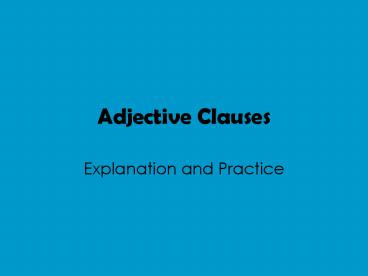Adjective Clauses PowerPoint PPT Presentation
1 / 9
Title: Adjective Clauses
1
Adjective Clauses
- Explanation and Practice
2
What is an Adjective?
- An Adjective describes a noun. Remember nouns can
either be subjects, objects or objects of
prepositions.
- Which words are adjectives?
- unkind
- fast
- value
- careless
- silently
- old
- Which words are adjectives?
- unkind
- fast
- value
- careless
- silently
- old
3
What is an Adjective Clause?
- An Adjective clause is a dependent clause
(dependent word subject and verb) that
describes a noun. - You can imagine that an adjective clause is
taking two sentences about the same noun and
making them into one sentence.
- Examples
- Route 66 is a long road.
- This road goes from Chicago to California.
- Route 66 is a long road that goes from Chicago to
California.
- Examples
- The postcard shows a beautiful vista of the
Grecian coastline. - I bought the postcard.
- The postcard which I bought shows a beautiful
vista of the Grecian coastline.
4
Relative Pronouns
- We use relative pronouns to create dependent
clauses. - The relative pronoun replaces the word in common
between the two sentences.
- Examples
- Route 66 is a long road.
- This road goes from Chicago to California.
- Route 66 is a long road that goes from Chicago to
California.
Subject Relative Pronouns People Who or
That Things or Animals Which or That Possessive
Whose
5
Remember
- The relative pronoun must be next to the word it
describes. - Example
- Incorrect The sharks opened their mouths while
they swam by the boat which were full of sharp
teeth. - Correct The sharks opened their mouths which
were full of sharp teeth while they swam by the
boat.
6
Essential v. Nonessential Clauses
- You must understand whether or not the dependent
clause is essential information or extra
information in the understanding of the noun.
This impacts the meaning and the punctuation. - Essential clauses are also called restrictive
clauses. We DO NOT use commas with these clauses. - Extra clauses are also called non-restrictive
clauses. WE MUST use commas with these clauses.
Also, these clauses will not use the relative
pronoun that.
7
Essential v. Nonessential
- Can you understand a difference between these two
sentences? - My sister, who lives in Bel Air, has three
children. - My sister who lives in Bel Air has three
children. - In which sentence is it clear that I have more
than one sister?
- What about between these two sentences?
- He looked in the refrigerator, and he threw away
the food which was rotten. - He looked in the refrigerator, and he threw away
the food, which was rotten. - In which sentence is all of the food in the
refrigerator rotten?
8
Essential v. Nonessential How To Tell the
Difference
- Think about if a listener or reader would be able
to identify the noun without the adjective clause.
Example He is the man who works at the grocery
store.
This is essential (identifying) information.
Think about it as two sentences. He is a man. He
works at the grocery store. Without the second
sentence, you couldnt identify him. Notice that
a become the because the noun changes from
indefinite to definite because of the
identification.
9
Essential v. Nonessential How To Tell the
Difference
- Think about if a listener or reader would be able
to identify the noun without the adjective clause.
Example Maria, who works as a physicians
assistant, enjoys her job.
This is extra (non-identifying) information.
Think about it as two sentences. Maria enjoys her
job. Maria works as a physicians assistant. You
know her name from the first sentence. This is
enough to identify her.

